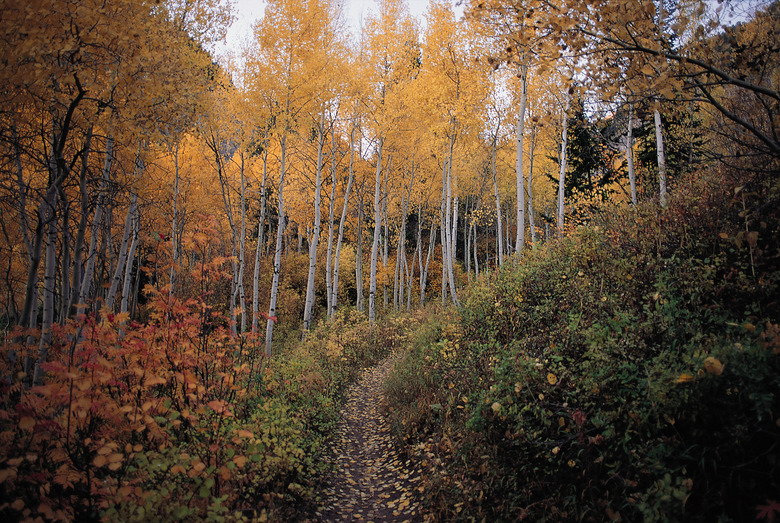What Are The Landforms Of The Temperate Deciduous Forest?
The temperate deciduous forest is one of the Earth's most diverse and populated biomes. Deciduous forests stretch up the east coasts of China, the United States and Australia, fill the islands of New Zealand and Japan, and cover most of Europe. The terrain – or landforms - of the deciduous forest are similarly varied. Flat, hilly and mountainous terrain is interspersed with large lakes and winding rivers.
Mountains in the Deciduous Forest Realm
Mountains in the Deciduous Forest Realm
Mountainous regions can be found in many of the world's temperate seasonal forests. In North America, the Appalachian and Adirondack Mountains rise from Alabama up to New York. Europe's Alps are largely covered with temperate deciduous forest and have given their name to other mountain ranges in temperate deciduous forest biomes, including the Northern Alps of Japan and the Southern Alps of New Zealand.
Higher mountains, however, often support different vegetation types at their upper elevations due to colder temperatures and shorter growing seasons (an example of ecological zonation). The deciduous forests of lower and middle slopes, for example, may transition into conifer-dominated forests higher up in Northern Hemisphere temperate mountain ranges, some of which (as in the Alps) may extend higher yet past timberline into alpine tundra.
Hills & Uplands
Hills & Uplands
A stretch of trees slowly rising and falling over changing terrain is a common sight in deciduous forest locations. The United Kingdom's Cheviot Hills form a boundary between England and Scotland, and the limestone hills known as the Pennines run down the center of the isle of Britain. In the regions of France that are not mountainous – largely in the center and northwest of the country – similar hilly terrain can be found.
Hills and uplands are also widespread in North America's deciduous realm, from the rolling country of the Piedmont, which in the east separates the foothills of the Appalachians from the coastal plain, to such midwestern United States uplands as the Baraboo Hills of south-central Wisconsin.
In such middle-elevation terrain, the landscape often doesn't rise high enough to where broadleaf trees are at a competitive disadvantage against conifers, and thus deciduous forest may broadly prevail over the entire upland complex.
Well-Watered Forests: Lakes, Large & Small
Well-Watered Forests: Lakes, Large & Small
Deciduous forests are wet and well-watered environments, so it is no surprise that the world's largest unfrozen freshwater system is located in the deciduous forest. The Great Lakes – Erie, Huron, Michigan, Ontario, and Superior – span over 700 miles of the border between the United States and Canada. These and many smaller lakes in the temperate deciduous forests of southeastern Canada and the northern United States owe their origin to Pleistocene glaciers, which scooped out basins in both bedrock and sediment and also left behind hollows as remnant ice bodies slowly melted away amid glacial drift, forming "kettle" lakes and ponds.
Other lakes form on alluvial floodplains when cutoff meanders of rivers evolve into "oxbow lakes." Small lakes may even result from the damming action of beavers, formerly widespread in deciduous forest locations in both North American and Eurasia.
Northeastern China is also covered by lake country. China's three largest freshwater lakes, Poyang, Dongting and Taihu, are all located in China's eastern deciduous forest.
Mighty Rivers of the Deciduous Forests
Mighty Rivers of the Deciduous Forests
In North America, the Saint Lawrence and Hudson rivers connect interior lake country to the Atlantic Ocean; the Missouri river runs from the prairie of Montana through the westernmost parts of the forest, where it meets the Mississippi river and flows into the Gulf of Mexico.
The Huang He, or Yellow River, flows east from central China and meets the Yellow Sea at Shanghai. Many of Europe's famous rivers flow into the North Sea from out of the deciduous forest: the Thames in England, the Seine of France, and the Rhine of Germany and the Netherlands.
Cite This Article
MLA
Zamboni, Jon. "What Are The Landforms Of The Temperate Deciduous Forest?" sciencing.com, https://www.sciencing.com/landforms-temperate-deciduous-forest-8168440/. 30 September 2021.
APA
Zamboni, Jon. (2021, September 30). What Are The Landforms Of The Temperate Deciduous Forest?. sciencing.com. Retrieved from https://www.sciencing.com/landforms-temperate-deciduous-forest-8168440/
Chicago
Zamboni, Jon. What Are The Landforms Of The Temperate Deciduous Forest? last modified August 30, 2022. https://www.sciencing.com/landforms-temperate-deciduous-forest-8168440/
